Since the time that this article was published, DVLED technology has advanced even further. Learn more about the advancements in direct view LED technologies in our more recent blog.
Direct View LEDs (DVLED) are garnering attention as the latest and greatest in display technology. DVLEDs have many benefits compared to projector systems when powering advanced display solutions. And while projection solutions will still be implemented and upgraded, DVLEDs are utilized for digital signage, immersive spaces and CAVEs, Virtual Production, and more; expanding both the space’s use-cases and the lifespan of the technology.
Modularity & Seamless
 Viewing Direct View LED can be molded and constructed to nearly any size and shape. LED technology is built from “modules” made up of tiny lights, called “pixels.” The modules are then stacked, shaped, and connected to create the necessary display size. These displays have the capability of displaying more vibrantly, and just as clear as projectors. Although, an advantage of projection can be resolution; they can achieve higher pixel density at a much lower initial cost than DVLED.
Viewing Direct View LED can be molded and constructed to nearly any size and shape. LED technology is built from “modules” made up of tiny lights, called “pixels.” The modules are then stacked, shaped, and connected to create the necessary display size. These displays have the capability of displaying more vibrantly, and just as clear as projectors. Although, an advantage of projection can be resolution; they can achieve higher pixel density at a much lower initial cost than DVLED.
Because DVLEDs can be shaped and built to custom specifications, immersive spaces do not have to be cube-shaped, or off in a separate room. DVLED solutions enable highly creative and custom designs, without sacrificing display quality due to projection calibration.
Mechdyne has designed and integrated DVLED cylinders, six-sided cubes, sweeping arcs, CAVEs, wrapping walls, floors, and ceilings; we can make your vision a reality with this technology. DVLEDs are also more durable than ever, a transparent coating allows for walkable floors and touchable screens, without impacting the display quality. Projection-based immersive solutions require multiple high-quality projectors and darkness to achieve a comparable experience to utilizing DVLED technology.
DVLED Offers Longer Life and Reduced Maintenance
One of the biggest advantages of LED technologies is longevity, maintenance and serviceability. DVLED displays a longer expected life cycle; rated as long as 100,000 hours. That is equivalent to 4,167 eight-hour work days; just over 11 years. And even at the 11-year mark, this calculation is based on losing 50% of the overall brightness of the display. Only under extreme ambient light situations is a display installed and running at full brightness on day one. This further extends the overall life expectancy of the display in “normal” installations.
Projection systems require consistent maintenance and upgrades to maintain the quality. Images can go out of alignment and colors can shift, requiring regular maintenance visits to bring the image back to acceptable standards.
![]()
Projection lamps require replacements at up to 5,000 hours, maximum, and even laserbased projectors have a lifespan of 25,000 hours. With a more limited lifespan, organizations can expect to invest large sums every few years.
Each pixel is a light source, in a fixed location. They image will not ‘drift’ or go out of alignment. Individual LED modules, and even pixels, can be repaired and replaced. With a proper spare parts cache, components can be “hot swapped” with minimum downtime of the display itself. Organizations that run their displays 24/7 with minimal downtimes, such as with digital signage or educational and entertainment purposes, should strongly consider DVLED.
Price of Direct View LED (DVLED)

In the case of projection technologies, pricing depends on the resolution, lifespan, and whether the projector is solid-state or lamped. With all these variables, a single high-end projector can cost anywhere between $30,000 and $100,000 each. With LED displays, the variables primarily depend on pixel pitch. Pixel pitch is the amount of space between each LED in the module. Typical pixel pitches, for boardroom style displays, are a very fine 0.6mm to 2.0mm for indoor displays. As the pixel pitch gets wider, the more visible/obvious individual pixels become to a viewer, especially the closer they get to the display. In turn, the closer the viewer is to the display, the smaller the pixel pitch needs to be. Organizations with workflows that allow users to be further away from the display can easily go for a larger pixel pitch. LED displays with larger pixel pitches start to become more comparable in price to projectors.
When it comes to price, it’s important to not just consider the initial investment. Total cost of ownership plays a critical role as well. When comparing LED solutions to a projector, also consider the lifespan and maintenance needs. An initial investment in a DVLED solution is often equal, or even more affordable, over the lifespan of the system in comparison to a projector solution that needs service visits and lamps/light source module replacement changes every few years.
Maximize Space
Projection solutions that require the projectors behind the screen need a large footprint due to the ‘throw distance’ of the light to the screen. This is variable depending upon the lens. Ultra-short throw distance lenses are available to shorten throw distances or allow projectors in front of the screens (so no room is needed behind the screens). However, these lenses can distort images and brightness from center to edge. Also, if the projectors are mounted overhead, two things happen; 1) the viewers hear the projectors directly overhead, and 2) they cannot approach too close to the screens because they will interfere with the projected light path, creating shadows on the screen. In contrast, LED systems are lightweight and don’t take up much space. There is no ‘throw distance’ since the pixels are the light source. The footprint is limited to the LED structure and panel depth, and the necessary computing system. The solution can be customized to fit within a space, rather than dedicating a space beforehand. Saving space is saving money.

Color
DVLED systems have the upper hand when it comes to color because it produces a life-like color balance. Each pixel is an emissive display. The color comes directly from the light source rather than being viewed through or on a screen, which can affect the color. LEDs are present color closest to what the human eye can perceive. Organizations that need the biggest, brightest, and most accurate should implement DVLED.

With light and color emitted from each individual pixel of DVLED systems, the color remains true throughout the space; in comparison, projector-powered solution display is impacted by distance between the screen and projector, ambient light sources, lifetime of the lightbulb, and number of projectors themselves. Projectors also require darkness for full-color display, while DVLED is high-brightness in any environment. Projected light is typically not uniform, with brightness typically dropping up to 10% from center to edge. If projectors must be arrayed to achieve larger and/or higher resolution images, projected images must be overlapped to balance brightness. Overlapping reduces the usable resolution from each projector.
Which Display Technology is Right for Your Organization?
Although it’s important to look at these considerations individually, it’s critical to keep in mind that these items work in tandem. Considering them all together rather than separately will ensure you invest in a technology solution ideal for your unique workflows and situation. To gain more insight about DVLED technologies, contact Mechdyne’s technical experts.
About Mechdyne
Mechdyne is one of the world’s leading providers of innovative visual information technologies. Mechdyne bends technology to our will in ways that transform complex data into insights and ideas. To ensure our customers succeed, Mechdyne provides comprehensive, customized solutions that include consulting, software, technical services, and hardware integration.


